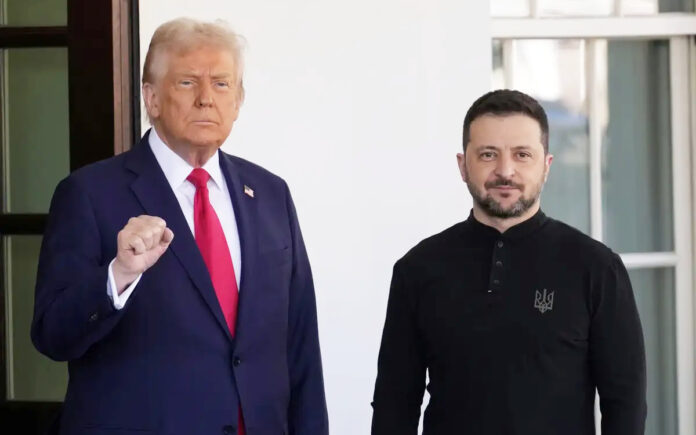Washington/Kyiv: In a development poised to reshape Ukraine’s war-battered economy and redefine U.S. foreign support, Washington and Kyiv have signed a landmark investment deal granting American access to Ukraine’s critical minerals. Finalized in Washington after weeks of negotiations, the agreement—named the United States–Ukraine Reinvestment Fund—seeks to recalibrate bilateral ties by shifting from military aid to long-term economic collaboration.
The deal, delayed several times due to political disagreements, is framed as partial compensation for the U.S.’s extensive assistance during the ongoing war. It also reflects a strategic recalibration of the Trump administration’s foreign policy objectives in Eastern Europe.
“This signals clearly to Russia that the Trump administration is committed to a peace process centred on a free, sovereign, and prosperous Ukraine over the long term,” said U.S. Treasury Secretary Scott Bessent during the signing ceremony.
Bessent added, “President Trump envisioned this partnership between the American people and the Ukrainian people to show both sides’ commitment to lasting peace and prosperity in Ukraine.”
From Battlefield Support to Economic Stakeholding
Departing from a primarily defense-based approach, the new agreement prioritizes economic access, granting U.S. companies involvement in extracting Ukraine’s strategic mineral reserves. These include titanium, lithium, uranium, manganese, and graphite—materials vital to sectors like aerospace, medical technology, clean energy, and electric vehicles.
In return, Ukraine anticipates not just capital inflow but a long-term political commitment from Washington.
“This is truly an equal and good international deal on joint investment in the development and restoration of Ukraine between the governments of the United States and Ukraine,” said Ukrainian Prime Minister Denys Shmyhal during a national broadcast. He emphasized that “Ukraine retains full control over its subsoil, infrastructure and natural resources.”
Deal Nearly Collapsed Amid Oval Office Tensions
The agreement’s path to ratification was far from smooth. Behind closed doors, the deal nearly unraveled during a tense Oval Office exchange involving President Donald Trump, Vice President JD Vance, and Ukrainian President Volodymyr Zelenskyy. Trump had earlier admonished Zelenskyy, suggesting that conceding Crimea might have shortened the conflict. More recently, the former U.S. president redirected blame toward Russian President Vladimir Putin, accusing him of undermining peace efforts with renewed attacks.
“The Ukrainians decided last night to make some last-minute changes,” Bessent revealed at a Cabinet meeting just before the signing. “We’re sure that they will reconsider that. And we are ready to sign this afternoon if they are.”
Eventually, a compromise was struck. The final deal outlines a 50-50 voting structure within the fund and explicitly excludes the repayment of past U.S. military aid. Only future American assistance will be counted as part of the fund’s capital, and all contributions must be in cash. Crucially, the pact avoids interfering with Ukraine’s EU accession ambitions.
Trump: “I Wanted to Be Protected”
For Trump, the minerals agreement underscores a strategic realignment away from open-ended military commitments.
Speaking to NewsNation, Trump stated the deal “in theory” means the U.S. will get more from Ukraine than it gave. “I wanted to be protected,” he added, “I didn’t want to be looking foolish by not getting money back for the investment.”
Shmyhal echoed optimism about the outcome, writing on Telegram, “The fund’s profits will be reinvested exclusively… [and] Ukraine will not be asked to pay back any ‘debt’ for the billions of dollars in U.S. weapons and other support since Russia invaded in February 2022.”
Ukraine’s Economy Minister Yulia Svyrydenko, who traveled to Washington for the signing, said, “Together with the United States, we are creating the Fund that will attract global investment to our country.”
The agreement still awaits formal ratification by the Ukrainian parliament.
Ceasefire Uncertain as Russia Digs In
While Washington and Kyiv pressed forward, Moscow issued cautious signals about the prospect of peace. Kremlin spokesperson Dmitry Peskov reiterated support for a ceasefire, but added that unresolved details remained.
“Before it’s done, it’s necessary to answer a few questions and sort out a few nuances,” Peskov stated. “We realise that Washington wants to achieve quick progress, but we hope for understanding that the Ukrainian crisis settlement is far too complex to be done quickly.”
Also Read | Court Orders Apple to End Anticompetitive Practices in App Store After Violation of Legal Order
Russian Foreign Minister Sergey Lavrov accused Kyiv of suddenly supporting a ceasefire only due to recent battlefield losses. Since 2022, Russian forces have advanced over nearly 20% of Ukrainian territory.
Human Cost Mounts as Conflict Persists
Meanwhile, the humanitarian toll continues to escalate. The United Nations reports a 46% surge in Ukrainian civilian casualties between April 1–24 compared to the same period last year. The U.N. Human Rights Office recorded 2,641 verified casualties in the first quarter of 2025—nearly 900 more than in 2024’s first quarter.
A Russian drone strike in Kharkiv recently injured at least 45 civilians, further highlighting the conflict’s unrelenting intensity.
Also Read | Appeals Court Blocks DOGE’s Access to Social Security Data in Major Privacy Ruling
Ukraine, too, has launched strikes into Russian territory. On Wednesday, Kyiv’s Security Service claimed responsibility for drone attacks targeting the Murom Instrument Engineering Plant in Russia’s Vladimir region. While Ukrainian sources reported five explosions and a fire, the claims remain unverified.
A Precarious Balancing Act
With military aid declining and economic survival at stake, Ukraine is betting on foreign investment to navigate the war’s next phase. The minerals pact is both a political and economic gambit, reflecting Washington’s desire for returns and Kyiv’s bid for sovereignty amid war and diplomacy.
As the world watches the evolving partnership, questions remain: Will this deal usher in peace and prosperity—or deepen the geopolitical quagmire?



